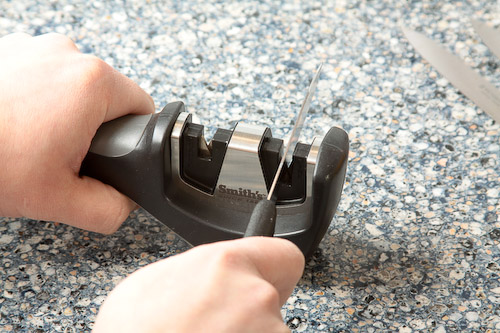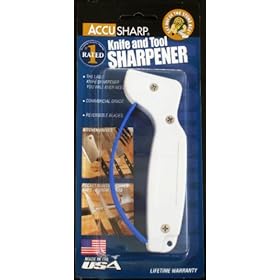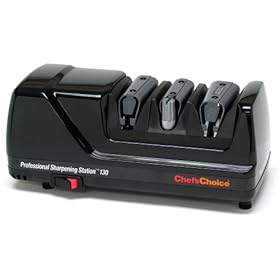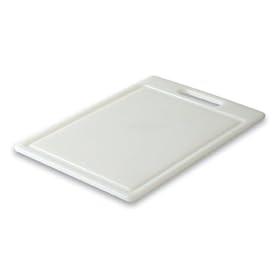The knife in question:

Cuisinart 8-inch stainless steel chef's knife. The thing I've been cutting myself with lately.
(Available from Cuisinart for $28)
I like this knife for smashing garlic because of the width of its blade. I also like to use it for chopping stuff, like onions or nuts, because the curvature of the blade helps me get more motion and speed going and I can really move through the pile of stuff on the cutting board.
But in the past week, I have cut myself with this knife, twice. Badly. The first time I was thinking I was all Top Chef while I was chopping onions and my ring finger somehow sneaked under the blade and zappo! I cut it right open beneath the nail. Man, that hurt. Bled a lot, too. Over a week later it's still tender, and there's a red line across my finger where the cut has mostly healed. I'd take a picture of it to show it to you but right now it's covered by a bandage because I cut that finger again.
This time I was slicing raw turnips (mmm, turnips! Snappy!). If you've ever cut a turnip, you know how unyielding they are. So I was bearing down on a slice that was fatter than I wanted, stupidly trying to slice it again. I was even thinking I was holding the turnip slice in a dangerous way. I must have had my hand underneath the slice with the tips of my fingers pointing upwards, steadying it, while I was bringing the knife down into the slice. That seems crazy but that's how I must have been doing it. Sure enough, the knife slipped and whappo! sliced open the tip of my ring finger, middle finger, and index finger. Yeah, pointer man got it too.
Once upon a time long ago I had to go to the emergency room because I'd accidentally cut myself so badly with a kitchen knife that I had to get stitches. That time, I was cutting orange slices. The nurse in the ER said, as she was pushing the needle into my finger, "I bet it was a bad knife, too, wasn't it?" I said yes. It was a crappy serrated thing I had gotten in a dime store or someplace like that. She said, "It's the dull knives that do the most damage. As soon as you get home, throw that thing away." I did exactly as she said.
So I'm thinking that maybe this fancy-pants knife is dull and therefore dangerous. I'm thinking it's time for me to acquire some knife knowledge. The future of my fingers seems to be at stake.
Is Your Knife Dull?
- There are a couple of tests to see if your knife has gone dull. One is to use the knife to slice a piece of paper at its edge. If the paper only crumples under the knife, it is super dull. If the knife cuts the paper, but the cut is jagged and shows signs of tearing, the knife is dull. What you want is for the knife to cut the paper easily and for its cut to be smooth with no signs of tearing or pulling.
- The second test is the tomato test. Lay the knife sharp edge down on a ripe tomato with its skin on. Don't press down but let the weight of the knife be the source of pressure against the tomato. Slide the knife back and forth about half an inch or so. If the knife penetrates the skin and makes a cut, it's sharp enough. If the knife only rubs against the skin, it's too dull.
- Another way to tell is by regular use of the knife. If, while you're cutting vegetables, you find you have to press down hard to get the thing to work, your knife is too dull.
- My knife, as it turns out, was a miserable failure at cutting the paper. It acted more like a hammer than a knife and crumpled the edge of the paper. If I stabbed the paper and then drew the knife down, it made a cut, but it looked more like a tear. I don't have a ripe tomato at the moment, but I've been aware for some time that I've had to push hard to get it to cut through vegetables, especially ones with tougher skins.
- The fact that I've been pushing hard with my knife may be why the first injury to my ring finger still hurts--besides cutting the skin perhaps I also bruised it with the force of the knife.
Why Dull Knives are Bad
- People tend to be afraid of sharp knives. That's a good thing; you should treat them with caution. But you're more likely to injure yourself with a dull knife.
- A sharp knife will cut food quickly and easily with far less pressure. One stroke and ffft! the thing is cut.
- With a dull knife, you'll tend to push down on it harder to force it to cut. You'll be gripping that turnip hard and bearing down with the knife. But that dull knife isn't going to slice through that turnip as easily. Instead, it's more likely to glance off the surface of the turnip, and since you're gripping that turnip hard you're less likely to move your hand out of the way and bingo, you've cut yourself.
How to Sharpen a Knife
- It's true that those sharpeners on the back of can openers are no good. They usually throw off sparks, which means the sharpener is removing red-hot pieces of metal, which in turn means that the knife is being overheated, which will weaken the metal. If you don't see sparks, you may smell a sort of metallic, burning odor, which amounts to the same thing. Don't use those.
- Those sharpening steel things that you get with a knife block don't actually sharpen a blade. In fact, they "unfold" the edge.
- When you use a really sharp knife, the edge is so fine that the pressure of cutting with it causes that edge to fold. That's what makes the edge dull.
- The sharpening steel thing will unbend that fold and make it stand up again. But this happens only when the person using the sharpening steel thing is really good at it. Even then, the folded part is now weakened from having been bent and unbent. It will probably fold over again really soon, after as few as 10 cuts of the knife, or it may break off altogether.

An example of a "sharpening" steel. But these things don't actually sharpen. They'll "unfold" a knife's edge, but you have to use these pretty much every time you use the knife, you have to know what you're doing, and it still might not even make the knife do what you want it do.
(This happens to be a J.A. Henckels 9-Inch Poly Sharpening Steel
- What you want is an actual sharpener.
- Specifically, you want a sharpener that doesn't wobble as it's drawn across the blade. A wobbling sharpener will create an edge that's not uniform. Instead the edge will sort of wander, and you'll have some spots that will seem dull and others that will seem sharper. A consistent edge is better than a precision edge.
- If you're adept at sharpening and you know what you're doing, you can use free-form sharpeners like water stones or sharpening rods. But if you're like most people, you're not skilled at knife sharpening, nor do you want to spend months learning how to do it.
- In that case, you want a tool that's going to hold the knife steady for you and put a good edge on the knife for you.
- There are lots of inexpensive, hand-held, non-electric tools. Some of them require you to hold the tool stable and draw the knife through it, while with others you hold the knife steady and draw the tool over the knife. Personally, I think holding the knife steady would give me more consistent results, but that may be a matter of individual preference.
- Because there are lots of cheap sharpeners out there, lots of them aren't very good. You want to look for a tool that's going to keep the knife as steady as possible, which usually means some sort of built-in guide or stabilizer. You also want the abrasive method to be as sharp and precise as possible.

I left this photo big so you could see the little channel thing where you put the knife blade. See those criss-crossing metal triangles? Those are the abrasives that will sharpen the knife. But they will sort of part back when you place the knife in there, and they'll help keep the knife in place as you draw it through, as will the black plastic things. This sharpener from Smith's is one that comes well-recommended.
(Photo from Cookography)
- Some people say to use only sharpeners with 100% diamond abrasives, but others say that it doesn't have to be that intense. These latter folks say that if you have something that's less immediately abrasive, that's okay because you need to sharpen your knives often anyway, and regular sharpening is better than a super-sharp edge that dulls quickly and doesn't get sharpened again for a long time.
- The downside to hand-held sharpeners in general is that it may take quite a while to sharpen an especially dull blade. If the blade has little divots in it, a hand-held sharpener won't deal with those.
- If you do go for a hand-held sharpener, read up on them first and find ones that have gotten lots of positive recommendations.

My mom gave me this hand-held sharpener for Christmas. With this, you hold the knife steady and draw the sharpener over the knife. It has those criss-crossing abrasive blades in there, which in this case are made of tungsten carbide. I tried it on my way-dull knife, and I could definitely see and feel little metal bits coming off of it. After many passes with this sharpener, my way-dull knife did better at the paper test, but still not great. This sharpener seems pretty low-rent, both in its design and its $10 price tag. But 187 out of 235 people gave it 5 stars, and a lot of people say they like this better than their electric sharpeners. I tried its companion product, a scissor sharpener, on a really old pair of scissors, and that worked great. So it could be that this knife just needs serious help.
(To be specific, this is the AccuSharp 001, and it's going for $9.94 on Amazon)
- Electric sharpeners used to be bad news because they'd wear a knife down lickety split without even sharpening it. All they did was grind off bits of the knife but never gave a sharp edge.
- Now, however, electric sharpeners are made to be much more precise. In fact, a good electric sharpener can sometimes "rehabilitate" a knife that's got issues besides dullness.
- Electric sharpeners usually keep the whole sharpening process more stable, the good ones can handle lots of different types of blades, and it won't matter whether you're left- or right-handed.
- They work much more quickly than a hand-held sharpener -- which means a bad sharpener can screw up a knife that much more quickly. For this reason, if you're going to go electric, you're going to have to be willing to pay extra for a decent one.
- Again, do your research and find an electric sharpener that comes well-recommended. With this type of tool, quiet operation is an important indicator. If the thing is loud, that probably means it's grinding away too much material.

This electric sharpener, the Chef's Choice M130, got 197 reviews on Amazon, 145 of which were 5-star. This thing has 100% diamond abrasives, it can sharpen pretty much any type of blade including serrated blades, and it automatically adjusts to the angle the blade requires. The three slots are progressive and, used one after the other, result in "hair-splitting sharpness." It'll set you back $150 on Amazon.
- Another option is to take your knives somewhere to have them sharpened professionally. The plus side here is that -- if you've done your homework -- you can be confident that the sharpener has done a good job. The down side is that if you rely on someone else to do it, you're less likely to have your knives sharpened as often as you should.
- You might be thinking, so why bother with all this? Why not use those "never-needs-sharpening" knives? Because, in short, those knives are crap. They have serrated edges, which would turn a typical knife sharpener to mincemeat. And serrated edges do, in fact, grow dull over time. When these get dull, they're even more dangerous than a traditional blade because now you've got all sorts of little dull edges that can cut your skin and instead of making one cut, they'll sort of chew and grind up your skin.
- That time I cut my finger and had to get stitches? That was from a serrated knife. Don't use those. Or if you do, make sure you have a way to sharpen them.

These serrated knives look like el cheap-o bad news to me. Sure, the "awesome colors" make it easy to find them in the drawer, and yes, they come with a little sheath to keep the blade from getting dulled when in the drawer. But they look like the handle could snap off at any time and what happens to that non-stick coating when you try to sharpen it? Major bad news, methinks.
(Knives available for $12.89 each from Delight.com)
Knife Maintenance
- There are some things you can do so that your knives stay sharp longer.
- Don't store them willy-nilly in a drawer with other metal cutlery. The knife will get bumped against other metal objects which will dull the knife quickly. Store a knife in a butcher's block or on a magnetized rack or in its storage case where it won't interact with anything else.
- The harder the surface you cut on, the faster the knife will go dull. Polyethylene or polypropylene boards are best. Wooden cutting boards are next best. Acrylic boards, glass, stainless steel, granite, marble -- all these surfaces will dull your knives in a hurry.

An example of a polyethylene cutting board. They're pretty standard, available all over the place. This one goes for $10 on Amazon.
- Don't scrape chopped food off the cutting board into the pan using the knife edge. Flip the knife over and use the back of the knife to do this.
- Sharpen your knives regularly.
The whole time I've been working on this entry, a line from a Louise Erdrich novel has been going through my head. Karl Adare, an untrustworthy knife salesman, knocks at Celestine's door. She knows he means nothing he says, but she buys his knives anyway. When he comes back again, before they wind up in bed together, she says to him, "Your knives are duck bait."
I hope for your safety's sake that no one can say of you, "Your knives are duck bait."
Sources
Sharpening Supplies.com, What Is Sharp?
everything2.com, How to test if a knife is sharp
Chef's Choice, Knives & Knife Sharpeners: Myths & Facts
Ken's Knife and Scissor Knowledge
Cookography, Knife Sharpening for Real People
I've used the sharpener that you said your mom got you, and I really liked it!
ReplyDeleteNice site good information provided in your site please visit our site http://www.viennafareast.com/ and give some valuable suggestion to us also
ReplyDelete